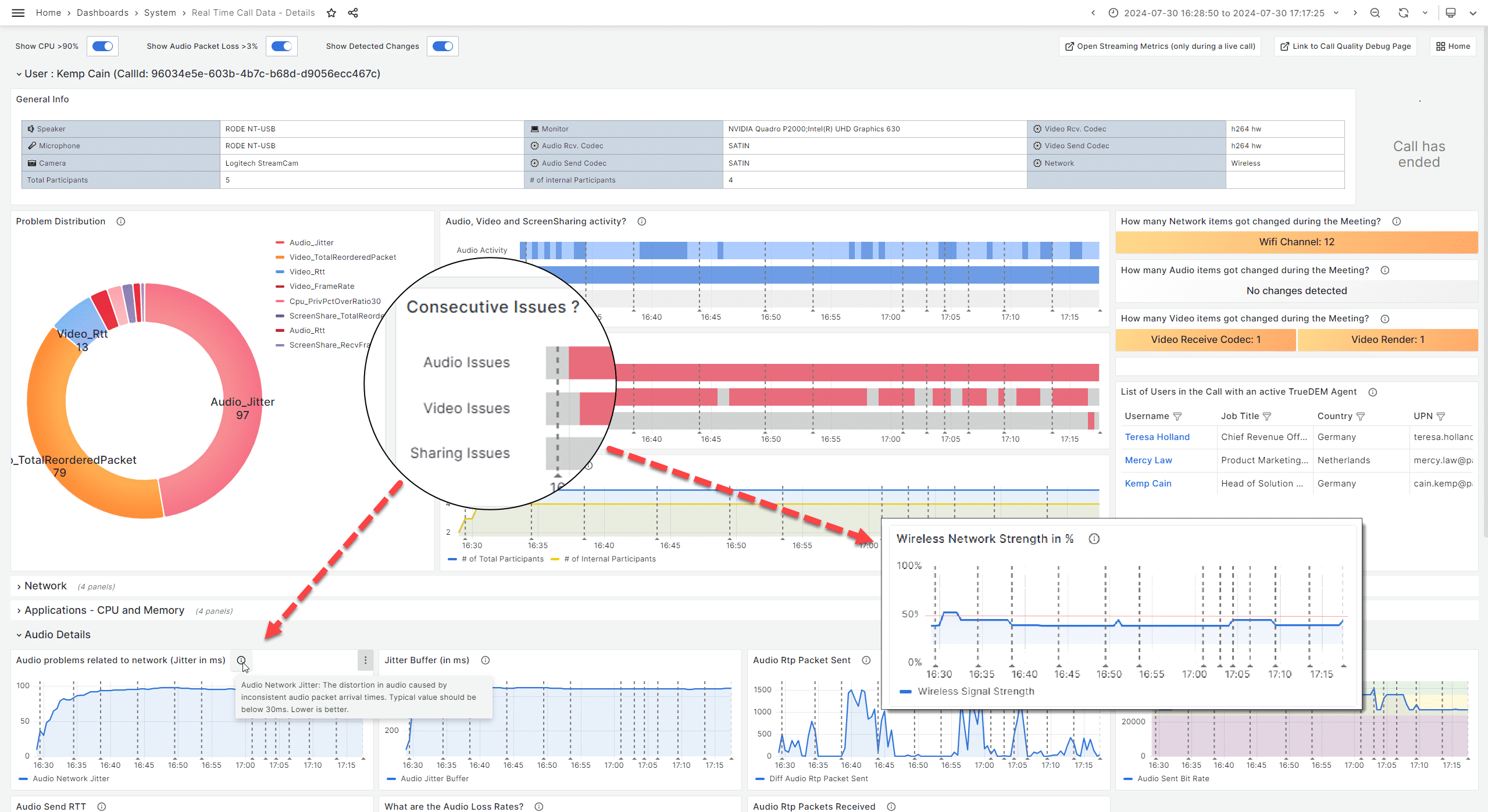Use Case
Proactive Remediation for Teams Call Quality Issues
In today’s hybrid workplace, Microsoft Teams calls and meetings have become a backbone of daily productivity. Employees are spending an unprecedented amount of time in virtual meetings, which means the quality of those calls directly affects work outcomes and employee experience.
According to Microsoft’s survey of 31,000 frontline and knowledge workers, users spent an average of 7.5 hours per week in Teams meetings back in 2022.
Those numbers have only grown since. With 320 million active monthly users going into 2025, Microsoft Teams has cemented its role as a cornerstone of modern work and Teams meetings & calls are an integral part of day-to-day business for most knowledge workers. Becoming the de facto form of (internal) communication for many. In this context, poor call quality isn’t just annoying — it’s disruptive to business outcomes.
To keep pace, IT teams need smarter, more adaptive tools to proactively detect, diagnose, and resolve call quality issues — especially with users distributed across home networks, office branches, and on-the-go connections.
The Call Quality Conundrum: A Visibility Gap
Ensuring high-quality Teams meetings can be a challenge because modern IT environments are complex and traditional monitoring often falls short. Factors that play into this are:
- Work is happening everywhere: Employees work everywhere, from offices to home offices, to the local coffee shop around the corner, each with unique devices and networks. Traditional tools lack insight into what’s happening on remote devices and networks, making remote user troubleshooting a constant challenge.
- So many potential points of failure: A Teams call traverses many stages—device, local network, ISP, public internet, and Microsoft’s cloud. 72% of users in a recent survey on hybrid work said they’ve lost time and started meetings late due to technical difficulties. A hiccup at any point degrades quality, and without end-to-end visibility, pinpointing the cause is like finding a needle in a haystack, especially for intermittent issues.
- Limited User Feedback: Relying on user reports drastically underestimates the true scope of call quality issues as many minor call quality issues often go unreported. Users tend to tolerate small glitches, meaning IT only hears about problems when they really start having a major impact. Causing irritations and frustrations to build up and problems to silently fester and grow.
- Inadequate native tools for user-level details: Microsoft’s admin tools offer high-level analytics but often lack granular, real-time data from individual user devices and environments.
These factors create a visibility gap. IT struggles to improve what they can’t fully see or measure. A new approach is needed — one that collects rich, end-to-end data to provide comprehensive insight into every call for every user.
Enhancing Call Quality Through Advanced Monitoring
By leveraging panagenda TrueDEM, organizations are embracing a new approach to overcoming call quality challenges. One that is uniquely centered on comprehensive monitoring for the modern, hybrid work environment.
This advanced monitoring is defined by:
- User-Context Data Collection: Lightweight agents on user devices continuously gather detailed telemetry during Teams calls. This provides a 360° view of each call, correlating information on hardware, software environment, network conditions (Wi-Fi, latency, packet loss), and media quality metrics from each participant’s perspective. This deep insight allows IT to understand why a call had poor quality, not just that it did, taking into account each participant’s unique connection to and routing in the Microsoft cloud.
- End-to-End Visibility: This holistic, user-centric data allows for true root-cause analysis. For instance, if a participant has poor audio, TrueDEM can reveal if it’s due to high CPU usage from another process on their device or a specific bottleneck in their home network’s connection to the Microsoft cloud. This insight enables targeted actions, moving troubleshooting from guesswork to science.
- Real-time Insights: Live dashboards provide real-time insight into ongoing call metrics. Allowing them to identify when call quality deteriorates across specific sites or networks. This enables IT to proactively intervene, potentially messaging users with troubleshooting tips or taking behind-the-scenes steps to reroute traffic, minimizing user impact.
- Retrospective Analysis for Improvement: All collected data is stored, allowing IT and service owners to review historical trends. This helps identify recurring issues, such as problems tied to specific locations, software updates, or device models, driving continuous improvement in the overall call environment.
This data-driven approach fundamentally transforms call quality management, moving IT support from a reactive “wait for a ticket” stance to a more proactive and preventive one. One that has all the data they need for effective troubleshooting and retrospective analysis at their fingertips at all times and allows for improving the user experience for their users at a fundamental level. TrueDEM is designed to offer all this with a unified, user-contextualized view of all relevant call metrics.
Turning Call Quality Insight into Better Business Outcomes
TrueDEM turns Teams call data into actionable insight — enabling IT to resolve issues faster, reduce support overhead, and improve the digital experience for every user proactively. By making call quality measurable and manageable, organizations can minimize disruptions, boost productivity, and ultimately drive better business outcomes through more reliable collaboration.
